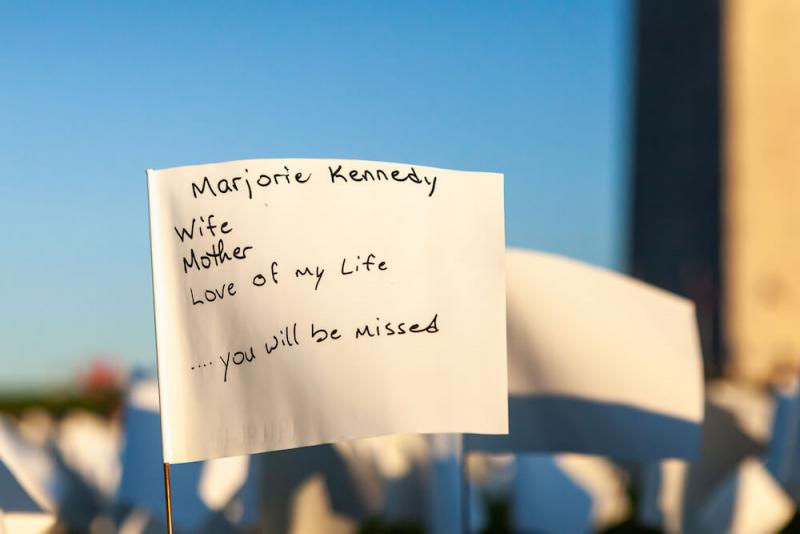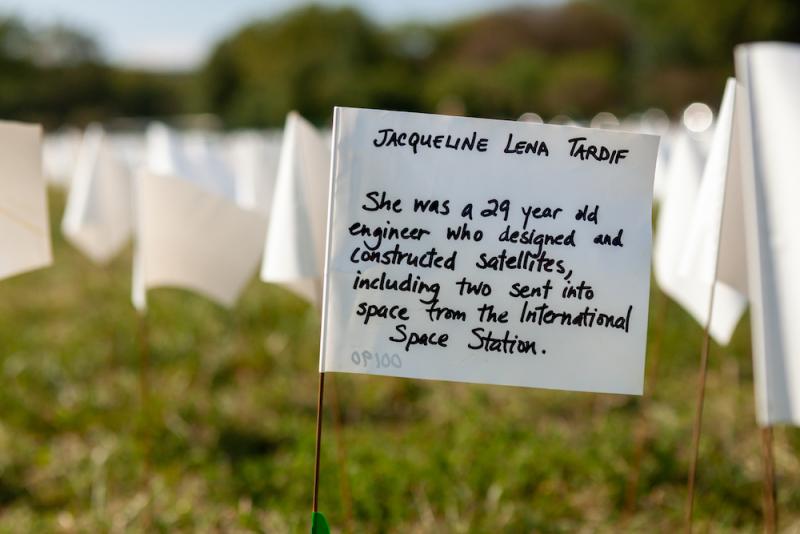Last year, Suzanne Brennan Firstenberg, a social practice artist, created In America: Remember — a vast field of flags on the national mall, one for each American who died from COVID-19. Visitors, both in-person and digitally, had the opportunity to dedicate a flag by writing a message on the white poly film. When the installation began in mid-September of 2021, there were 666,624 deaths. When the installation closed in early October, there were 701,133 deaths. As of this week, nearly 1 million people have died of COVID-19 in the United States, 6 million globally. As we try to grapple with the weight of these fatalities, we’re revisiting an interview from late October 2021 between Firstenberg and Sojourners associate culture editor Jenna Barnett, in which they discuss what it looks like to honor grief and memorialize an ongoing pandemic.
umbrella.png

The following interview has been lightly edited for length and clarity.
Jenna Barnett, Sojourners: Will you describe In America: Remember?
Suzanne Brennan Firstenberg: When I created In America: Remember, I could only hope that people would get out of it what they needed to, and they did. Some people viewed it strictly as data visualization: I helped make understandable — to the extent that it can be — the number 700,000. Other people viewed it in its most traditional sense as a memorial. Broadly, In America: Remember is the physical manifestation of empathy. The power of art lies, not in the artist’s hands, but in the viewers’ hearts and souls.
When I created this carefully designed and orchestrated field of hundreds of thousands of flags, I knew that people would bring their grief and their anger and outrage with them. But what I really didn’t know is what the flags would give back. I am so pleased and proud of the flags for doing their duty. People came thousands of miles to write words on 5-by-4-inch poly film attached to a steel stem. Each time somebody dedicated a flag, they were my co-artists. Think about the power of art in their grief process.
There was one woman who lost her father almost a year ago. She came [to Washington, D.C., and saw] a vast field of flags for each person who died from COVID. She said, “Suzanne, all this time, I’ve been grieving alone. And this helps me understand it that I was never, never alone in my grief.”
Barnett: Why do you think it's important for us to grieve in public rather than each of us just having private, singular grieving processes?
Firstenberg: In this particular instance, ceremonial grief processes have been interrupted because of the pandemic. So having this public acknowledgement validates not only the person who has died, but also the grief of the family. This has demonstrated to me that we have to find new ways to address, acknowledge, treat, and respect grief in this nation.
A woman came up to me [at the installation] and she was in tears. Her mother died when she — the daughter — was eight months pregnant. This new mother told me that at work, they just don’t understand. She said, “It's like PTSD. They sent me the flowers. They sent the requisite condolence cards. But is that really where caring for somebody in grief stops? Because every day at work, they don’t talk about taking care of each other and taking protective measures. They don’t talk about the victims.”
She works in a news organization that doesn’t really pay attention to that. She said it was painful to go to work each day and not have that grief acknowledged. She taught me that we must question whether an employer’s responsibility ends at the bouquet and the condolence card.
… We don't have signs or symbols that suggest grief. We don't have periods of mourning. We treat the one sure thing in all of our lives as if it’s never going to happen. That doesn't allow us to live fully.
Barnett: How was it for you to bear witness to all of that? — to, in many ways, actively participate in the grief of thousands of people?
Firstenberg: I am very lucky and privileged to have been a hospice volunteer for 25 years. I bring to this art that understanding and that willingness to witness grief. I think that helped me tremendously in knowing what to say. And more importantly, knowing when to be quiet, because sometimes in bearing witness to grief, there’s nothing to say, but there’s everything to hear. And so many people will say to me, “Oh, Suzanne, what should you say to somebody who’s just lost a loved one?”
And I'll say to them, “The best two words you can say is, ‘tell me.’” The most respectful thing to say isn’t always I'm sorry for your loss, which can really shut down conversation. “Tell me” is so giving.
marjorie.jpg

Barnett: Right, the gift of presence, which has felt more difficult during a pandemic. With that in mind, will you talk about the digital aspect of the installation?
Firstenberg: It was important to us to make sure that people had equal access to this art. So many people who had suffered losses due to COVID could not afford the time or the expense of coming all the way to Washington, D.C., to dedicate a flag. We made sure that people who would not be able to attend could dedicate flags through our website. We had the dedications printed on cards and brought to the mall where volunteers could help create those flags for them and plant them for their families. And then we would photograph them and attach that to the digital records so that the photos of those flags would appear on the website just where they were planted on the mall. Some people say it was a real complication to the art, but I think it was an incredibly important enhancement because it aligns with my values as an artist.
Barnett: How did you end up settling on white flags?
Firstenberg: There are very few units of anything that could be respectful enough to commemorate a person’s life. And especially there were very few units that would be respectful enough that I could afford, and so these small white marking flags made sense. Think about [the field] if those were American flags. Think of how that would feel. That iconography wasn’t appropriate. It almost would have hijacked the emotional content. White is the color of innocence and purity, and these were innocent victims of this pandemic. Nobody wanted to die from this dreadful virus.
[Also,] it could be written on, and dedicating these flags was a critical element of the art because it’s one thing to see a field of 700,000 flags. But if you’re walking through this immense field and then look down, all it takes is reading one flag — reading the name or the fact that it was a World War II veteran or a kid who loved turtles — and thinking about all the griefs that one flag represented.
Barnett: Are there any flags that especially stood out to you?
Firstenberg: One that really struck me was written for a World War II vet. It said that he refused the use of a ventilator, asking that it be used for someone younger. Here’s a man who served his country in such a devastating war. And then he served his country again, by not accepting a very scarce resource that could have kept him alive.
There was another flag dedicated to a woman named Kitty. The flag writer had obviously begged Kitty to get the vaccine because she wrote: “I asked you to get vaccinated, but you said, God will protect me. The vaccine is from God. You passed the end of July.”
Kitty’s faith limited her in so many ways. And indeed in the most important way, her faith didn't protect her. I love the flag dedicator’s more holistic understanding of God — that God works through people, and science, and society.
I have one more really quick story. There was a couple who came to the art installation and they wanted to dedicate a flag to their physician because he’d been wonderful and he had died from COVID. So they came up to a reception table to ask if they could dedicate a flag to their doctor. The volunteer said yes and asked for the doctor’s name. When they told her, she had to introduce herself. She was the doctor's widow. That’s the kind of thing that happened over and over again in the flags.
… Emotionally [the installation] was very difficult. And yet it was immensely gratifying because we created space where strangers could talk with strangers about things that matter. We weren’t talking about the weather; we weren’t talking about sports scores. We were talking about human lives. I had the privilege of watching strangers console strangers. That was it. That was the magic of the place.
jaqueline.jpg

Got something to say about what you're reading? We value your feedback!







